Description
Bean, Phaseolus vulgaris, is a versatile legume widely cultivated across the globe for its edible pods and seeds. Belonging to the Fabaceae family and Phaseolus genus, it encompasses numerous varieties with distinct characteristics and uses. Originally from the Latin America, beans are vital for food security in many parts of the world, particularly in sub-Saharan Africa. They thrive in various agroecological zones, from lowlands to highlands, and from arid to humid regions.
This staple crop is extensively cultivated in countries like Ethiopia, Kenya, Tanzania, Uganda, and Nigeria, among others. The types of beans grown include bush beans, green beans, and kidney beans, each offering unique flavors and culinary uses. Bean varieties exhibit diverse pod shapes, colors, and sizes. Pods range from flat to round, with hues spanning from green and yellow to red and purple. Beans themselves vary in shape, from nearly spherical to elongated and kidney-shaped. Beans are primarily grown as either bush or climbing plants, requiring support for harvesting in the latter case. Varieties differ in pod fibrousness and seed quality, with colors ranging from white through various shades to black.
These legumes play a crucial role in global agriculture, providing essential nutrients and contributing to dietary diversity. They are a staple in many cuisines worldwide and are valued for their versatility and nutritional benefits.
Crop details
Scientific Name: Phaseolus vulgaris L.
Common Name: bush beans, common beans, dry beans, dwarf beans, field beans, garden beans, kidney beans (En); haricot (Fr); feijão (portuguese); fagiolo (Italian)

Bush bean in flower

Purple snap bean variety

Runner bean flowers

Pole bean plant with pods

Green bean flowers and pods

Green beans
Uses & Benefits
The common bean is used as a pulse and green vegetable eaten fresh or cooked. The beans can be dried, cooked in sauce and canned .The common bean is used as a pulse and green vegetable eaten fresh or cooked. The beans can be dried, cooked in sauce and canned.
Beans are among some of the oldest cultivated vegetables. There are various types of beans that differ with shapes, sizes, taste and nutritional facts. Kidney beans, pinto beans, broad beans, fava beans, lima beans, etc. are some of the different types of beans. Each of them is loaded with dietary fibers, proteins and major vitamins and minerals like vitamin A, vitamin C, potassium, calcium and magnesium. The amount of the above given nutrients varies from one type of bean to other. Beans are very low in fat and cholesterol and they also help to lower the bad cholesterol in the body. Since they are high in proteins, they make an excellent meat substitute for vegetarians. They are extremely low in calories and hence are a favorite food among the calorie conscious people. Before knowing more about beans nutritional value, let us take a look at some figures related to nutrition in beans.
Varieties of Beans
The following are the different types of beans.
Black Beans: are a staple in many Mexican and Brazilian dishes. They have a velvety-smooth texture and mild flavor. They also have a lower glycemic index than many other high-carb foods, helping to reduce the spike in blood sugar that occurs after eating a meal.
Black-Eyed Peas:This Southern staple has a beige hue with an eye-catching black spot, hence the name "black-eyed peas." They have an earthy flavor that complements salty foods like ham and bacon.
Cannellini Beans: Also known as white Italian kidney beans, these cream-colored beans are one of the most common types of beans. They are a popular addition to soups, salads, and many Italian dishes.
Chickpeas (Garbanzo Beans): They have a round shape and a firm texture, making them a great salad topping.
Great Northern Beans: This is another type of white bean that is often mistaken for cannellini or navy beans
Kidney Beans: These beans are known for their vibrant red skin and white interior. They have a mild flavor, and make the perfect addition to any chili recipe.
Lima Beans: These beans get a bad rap, but there's actually so much to love when it comes to lima beans. They can be white, creamy, or green in color.
Pinto Beans: Pinto beans have an orange-pink color with rust-colored specks
Fava Beans: Fava beans, or broad beans, can be difficult to work with. They require that you remove them from their pods and then blanch them in order to get the skins off.
Navy Beans:This bean goes by many names: haricot, pearl haricot beans, white pea bean, and Boston bean. They have a mild flavor and creamy texture, and similar to Great Northern Beans, they do a great job of absorbing the flavors around them.
Adzuki Beans: These small, round red beans , Like other legumes, they're protein-packed and high in fiber.
Edamame: Edamame are young soybeans which are usually eaten while still inside the pod.
Cranberry Beans: Rounding out the list are these striking cream-colored beans with red speckles. Also known as borlotti beans, cranberry beans have a creamy texture and a nutty flavor.
Soybeans: Soybeans are dried and beige in color.
Mung Beans: These beans are one of the most consumed types in the world. They are small, round, and green with a white stripe going through them. They have a mild flavor and a starchy texture
Propagation
Basic Requirements
Common beans are warm-season crops and should be planted after all danger of frost has passed and the soil has warmed. Beans will grow best at soil temperatures between 15.5 and 29°C (60–85°F) and are sensitive to cold temperatures and frosts. Beans will grow best in a fertile, well-draining soil with a pH between 6.0 and 6.75 Beans will perform best in full sunlight.
Growing from Seed
Beans should be direct seeded in the garden in when the soil has reached a temperature of at least 15.5°C (60°F), with the optimum temperature for germination being between 15.5 and 29°C (60–85°F). Planting at cooler temperatures leads to slow germination and promotes seed rotting. Seeds should be planted 2.5–3.5 cm (1–1.5 in) deep. Bush beans should be planted 5–10 cm (2–4 in) apart allowing 0.6–0.9 m ( 2–3 ft) between rows. Pole beans can be planted in both row and hills. In rows, seeds should be spaced 15–25 cm (6–10 in) apart allowing 0.9–1.2 m (3–4 ft) between rows. For a continuous harvest of beans over the summer months, make new plantings every 2–3 weeks.
General Care and Maintenance
Pole beans should be provided with a pole or trellis to climb on to support the weight of the pods and allow light to penetrate to all parts of the plant, helping to prevent disease. Bean poles should have a rough surface to help the plant to grip and should be 1.8–2.1 m (6–7 ft) long. Three or four poles can be used to form a tripod onto which the plants can be trained. Bean trellises can be constructed easily using posts (or a tripod arrangement of poles), wire and twine. Position a post at either end of the area in which you wish to plant a row of beans and connect with two lengths of wire. The first wire should be approximately 13 cm (5 in) from the ground, and the second 1.5–1.8 m (5–6 ft) from the ground. Finally, use the twine to create a V-shaped trellis by tying the twine to the bottom wire, bringing it up to the top wire and looping it back down around the bottom wire. Continue to zigzag the string all the way along the wires to the second support before tying the twine off. A rough textured twine is best as it will encourage the plant to climb and twine around it. Pinch back the growing tips of the plants once they reach the top support to encourage the plant to branch.
Mulching with straw and cut grasses helps conserve moisture, promote adventitious root development and enhances tolerance to bean fly maggot damage.
Beans are excellent for intercropping with other food crops, such as maize, potatoes, celery, cucumber and can help supply the other crops with nitrogen to a limited degree. Longer season varieties of beans can fix higher amounts of nitrogen than short season varieties. Intercropping with chives or garlic helps repel aphids (KIOF - personal communication).
A regular water supply is essential for French beans as moisture affects yields, uniformity and quality. Water stress during flowering reduces yields, as does waterlogging. Irrigation in dry spells is recommended as 35 mm per week at planting and 10 days post emergence, followed by 50 mm per week thereafter till end of production.
Harvesting
Beans are generally ready for harvest approximately two weeks after bloom. The beans should be harvested just before the seeds are mature and before they form bumps on the pod. The pods should be firm and snap when they are bent. Pick beans every 2–3 days to ensure the plants remain productive. Pinch beans rather than pulling to avoid damaging the plant. Cut pole beans from the plant using scissors.

Pole beans planted beneath a trellis

Bean tripod and trellis
References
CABI Crop Protection Compendium. (2008). Phaseolus vulgaris datasheet. Available at: http://www.cabi.org/cpc/datasheet/40626. [Accessed 06 November 14]. Paid subscription required.
Drost, D. (2010). Beans in the Garden . Utah State University Cooperative Extension. Available at: https://extension.usu.edu/files/publications/publication/HG_Garden_2005-08.pdf. [Accessed 06 November 14]. Free to access.
Lerner, B. R. (2001). Growing Beans in the Home Vegetable Garden. Purdue University Cooperative Extension Service. Available at: http://www.hort.purdue.edu/ext/ho-175.pdf. [Accessed 06 November 14]. Free to access.
Schwartz, H. F., Steadman, J. R., Hall, R. & Forster, R. L. (2005) Compendium of Bean Diseases. Available at: http://www.apsnet.org/apsstore/shopapspress/Pages/43275.aspx. Available for purchase from APS Press.
Common Pests and Diseases
Diseases
Category : Fungal
Alternaria leaf spot
Alternaria alternata
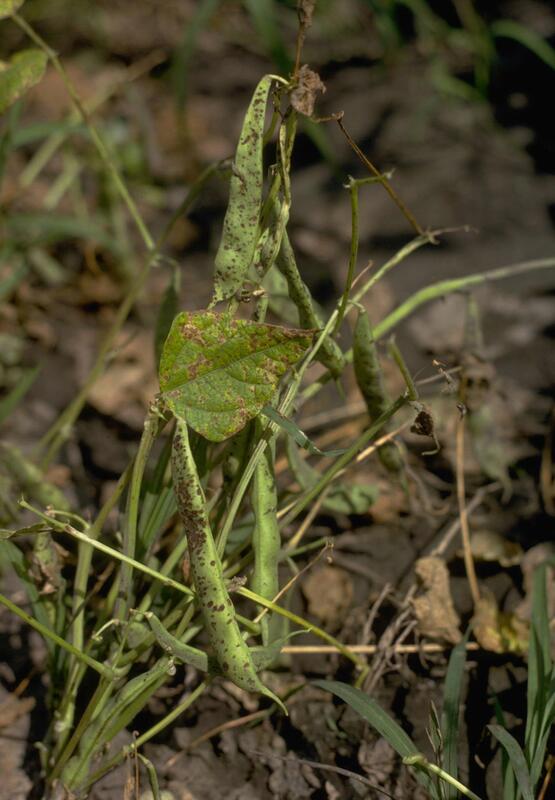
Symptoms of Alternaria leaf spot on bean leaves and pods
Symptoms
Small irregular brown lesions on leaves which expand and turn gray-brown or dark brown with concentric zones; older areas of lesions may dry out and drop from leaves causing shot hole; lesions coalesce to form large necrotic patches
Cause
Fungus
Comments
Management
Plant beans in fertile soil; foliar fungicide application may be required
Anthracnose
Colletotrichum lindemuthianum (Glomerella lindemuthiana)
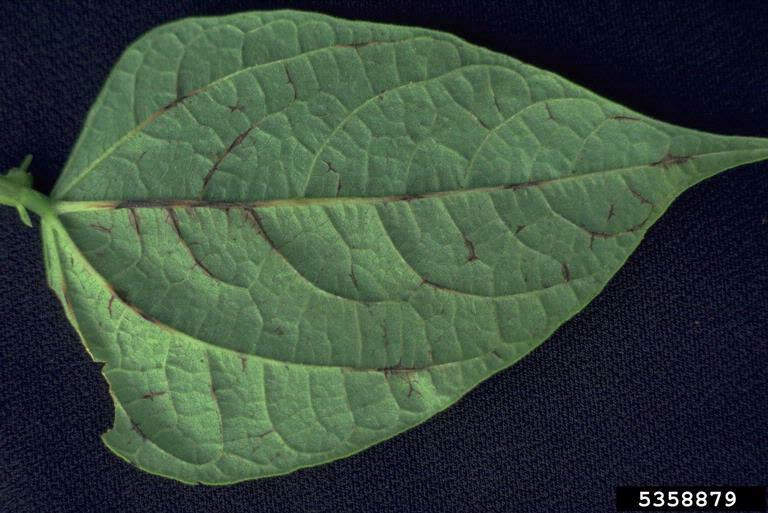
Infected leaf
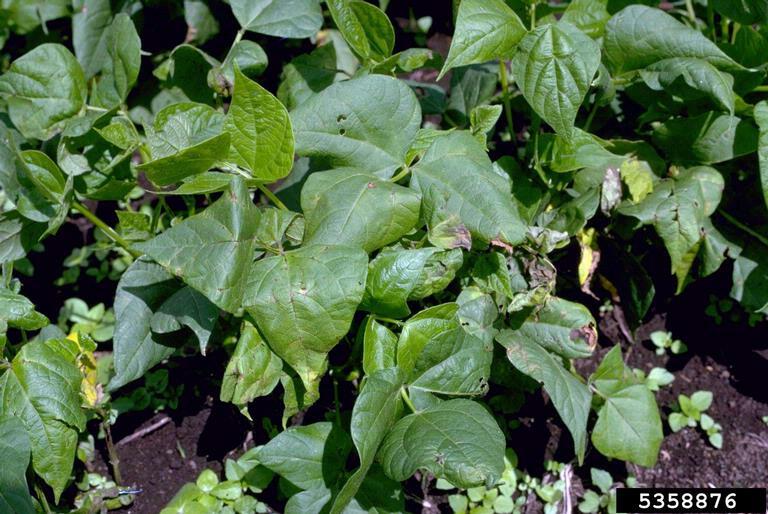
Bean plants showing canopy symptoms

Anthracnose symptoms on beans and pods

Anthracnose symptoms on bean pods
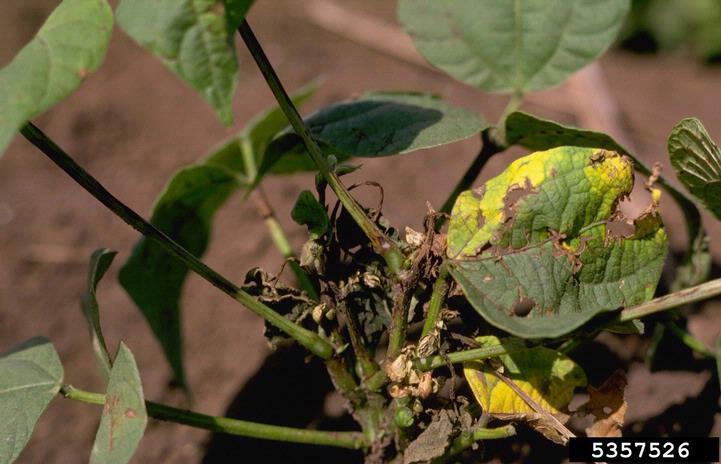
Infected plant

Close-up view of a bean pod, displaying symptoms of bean anthracnose

Close-up of anthracnose lesion on bean pod

Anthracnose symptoms on bean pod
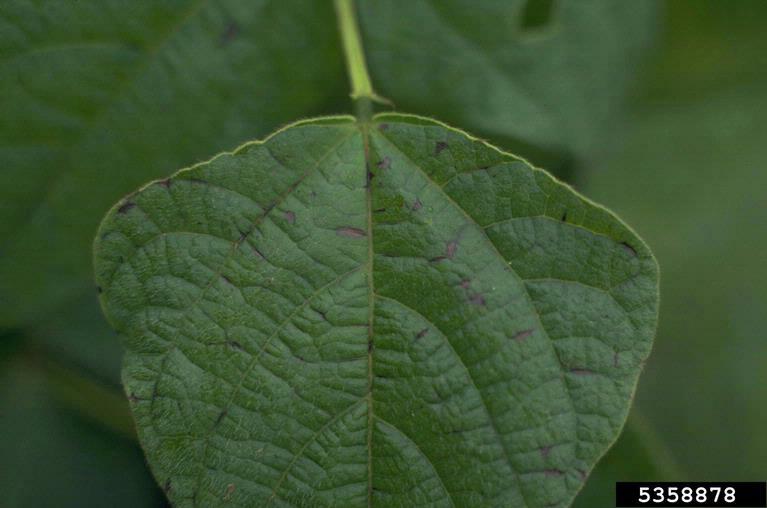
leaf showing symptoms of beans anthracnose

Close-up view of a bean leaf petiole, displaying symptoms of bean anthracnose

Symptoms of bean anthracnose

Anthracnose symptoms on bean pods
Symptoms
Small, dark brown to black lesions on cotyledons; oval or eye-shaped lesions on stems which turn sunken and brown with purple to red margins; stems may break if cankers weaken stem; pods drying and shrinking above areas of visible symptoms; reddish brown spots on pods which become circular and sunken with rust colored margin.
Cause
Fungus
Comments
Management
Plant resistant varieties; use certified disease free seed; avoid sprinkler irrigation, water plants at base; plow bean crop debris into soil.
Bean rust
Uromyces appendiculatus

Symptoms

Rust pustules on bean leaf

Telia of bean rust

small yellow or white spots due to rust disease

Bean leaves showing "green island effect" due bean rust disease

Close-up view of the pycnium of bean rust

Symptoms on beans stem

Initial symptoms of rust disease
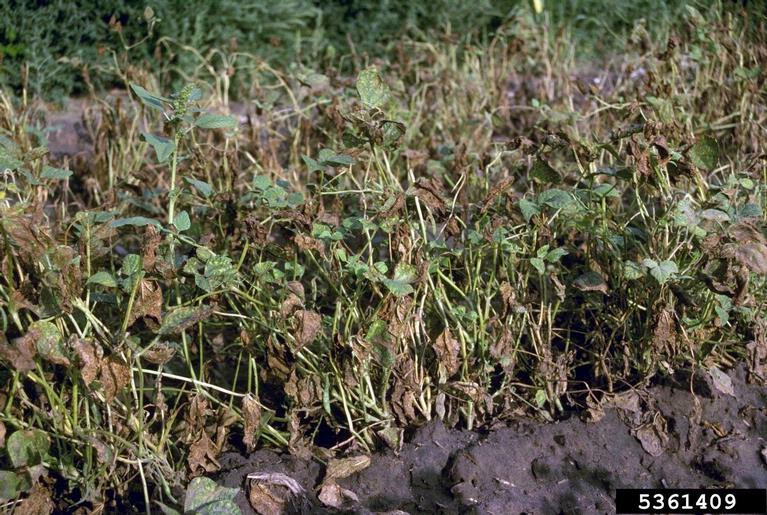
Rust disease infected plants

Field of dry beans displaying prominent symptoms of bean rust

Aecia of bean rust (Uromyces appendiculatus) on the stem

Teliospores formed on infected leaves

Rust symptoms on bean pod
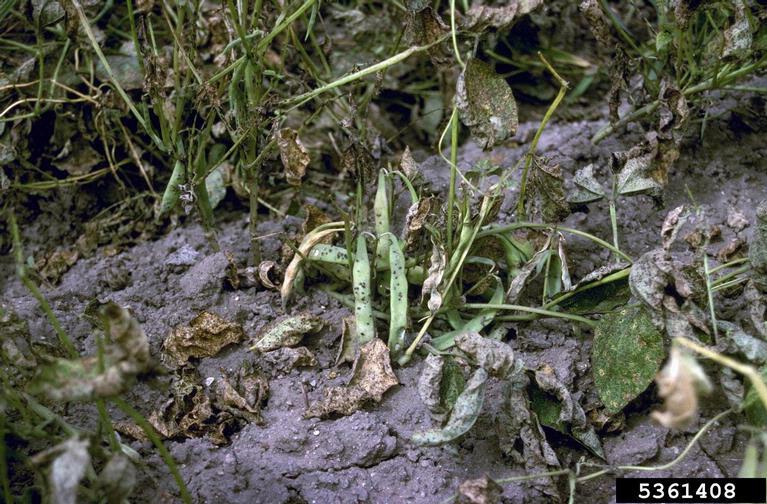
Defoliation of bean leaves due to rust disease

Telia of bean rust (Uromyces appendiculatus) on a bean leaf.
Symptoms
Initially the symptoms appear as small yellow/white spots on leaves. Later the spots become enlarged and shows raised brick red rust pustules (uredinia). Normally this pustules are surrounded by a yellow halo. Premature leaf drop may occur if the disease is severe.
Cause
Fungus
Comments
Management
Grow available resistant varieties. Remove and destroy the infected crop debris. Follow crop rotation. Keep the field free from weeds. If the disease is severe, spray suitable fungicide.
Black root rot
Thielaviopsis basicola

Symptoms of black root rot (Thielaviopsis basicola)

Elongated red-purple lesions due black root rot on melon seedling

black root rot (Thielaviopsis basicola) symptom
Symptoms
Elongated red-purple lesions on root tissue which turns dark gray to black; lesions coalesce to form large dark areas on roots and stems; deep lesions can cause stunted growth, wilting leaves, defoliation and plant death.
Cause
Fungus
Comments
Management
Rotate crops with non-susceptible grasses; avoid excess irrigation or drought stress.
Fusarium root rot
Fusarium solani

Roots of drybeans showing advanced symptoms of Fusarium root rot caused by Fusarium oxysporum f.sp. phaseoli.
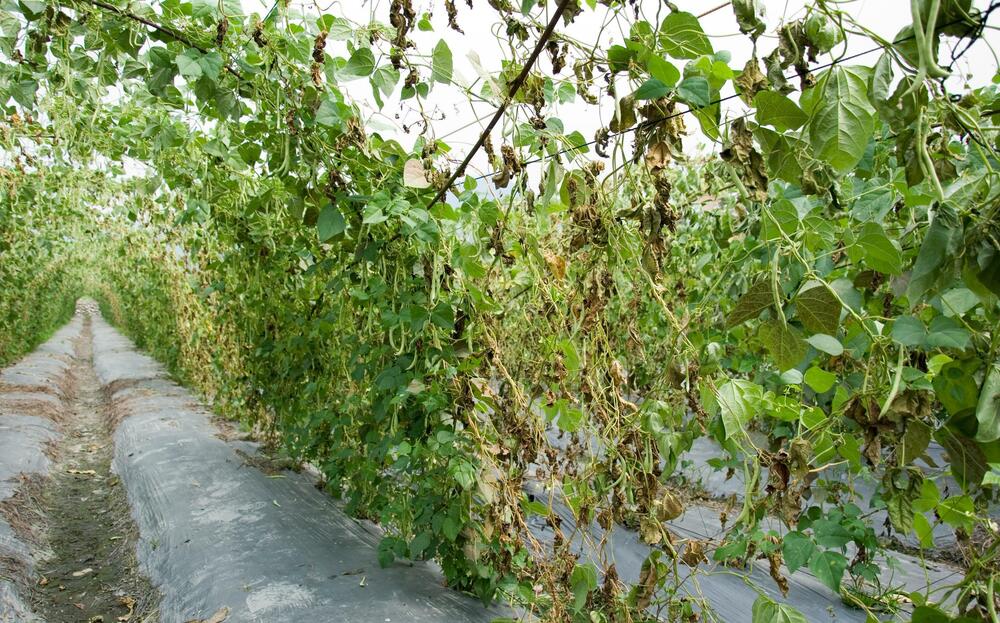
Bean plant showing symptoms of fusarium wilt
Symptoms
Young plants stunted with chlorotic leaves; older plants with chlorotic leaves and some leaf drop; severely decayed roots which are hollow and dry.
Cause
Fungus
Comments
Management
Practice long term crop rotation; avoid over or under watering plants; some bean varieties exhibit some tolerance.
White mold (Sclerotinia timber rot)
Sclerotinia sclerotum

Wilting of a dry bean plant in the field, an initial symptom of infection with white mold

Wilting and death of the bean canopy, an advanced symptom of infection with white mold

Advanced symptoms of white mold

White mold symptoms on bean plants caused by Sclerotinia sclerotiorum

Fallen blossoms of dry bean that have been colonized by white mold

Mycelium and sclerotia of white mold

Advanced symptoms of white mold (Sclerotinia sclerotiorum) on the branches and pods of a bean plant.
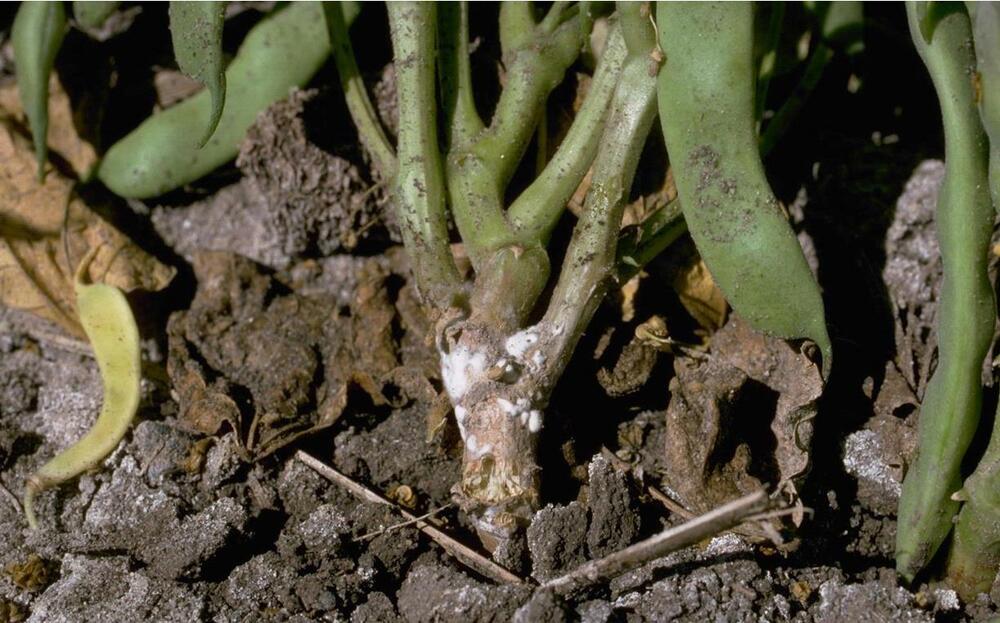
White mold on bean stem and branches

Field infested with white mold
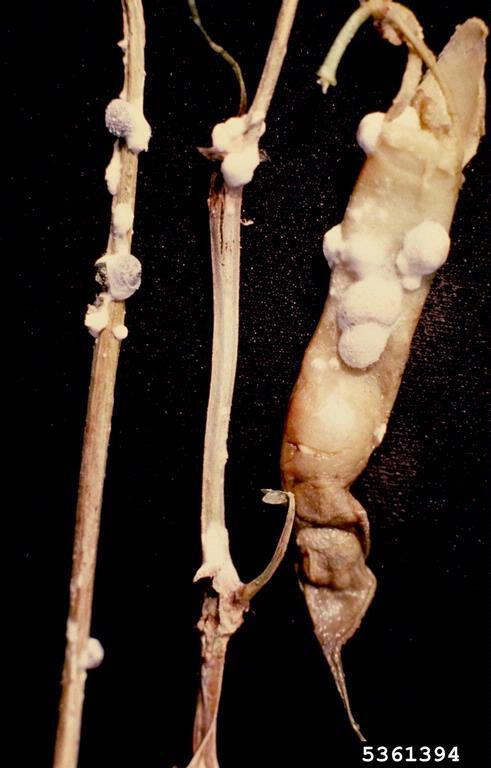
Symptoms in advance stage

Apothecia of white mold (Sclerotinia sclerotiorum) and fallen leaves of dry bean that have been colonized by white mold.
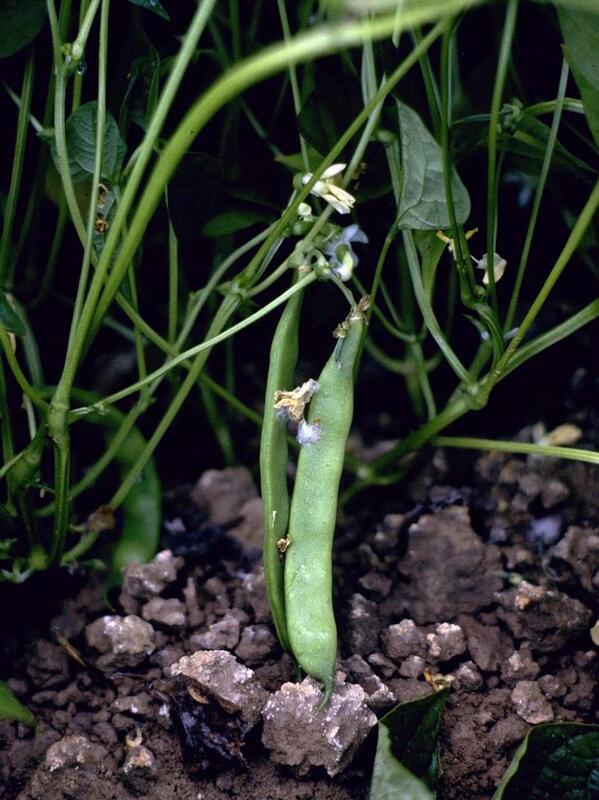
Bean pod and flower colonized by white mold
Symptoms
Flowers covered in white, cottony fungal growth; small, circular, dark green, water-soaked lesions on pods leaves and branches which enlarge and become slimy; cottony white growth may be visible on lesions during periods of high humidity; death of branches and/or entire plant.
Cause
Fungus
Comments
Management
There is no true immunity to white mold in any bean varieties; rotate crops with non-hosts like cereals and corn; plant rows parallel to direction of prevailing winds to prevent spread of disease from secondary hosts nearby; avoid excessive nitrogen fertilizer; use a wide row spacing.
Category : Bacterial
Bacterial blight
Xanthomonas campestris
syn. Xanthomonas axonopodis

Symptoms on lower surface of leaf

Symptoms on both upper and lower surface of leaves

Bacterial blight of beans

Symptoms of bacterial blight on bean foliage

Symptoms of common bacterial blight

Common bacterial blight water soaking on dry bean leaf, canopy symptoms

Lesions of common bacterial blight

Symptoms on bacterial blight on pods

common bacterial blight water soaking on dry bean leaf
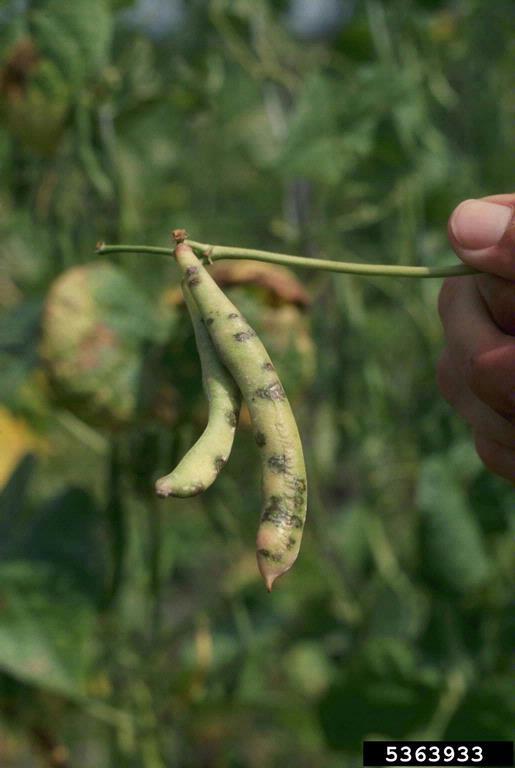
Common bacterial blight water soaking lesions on dry bean pods, disease
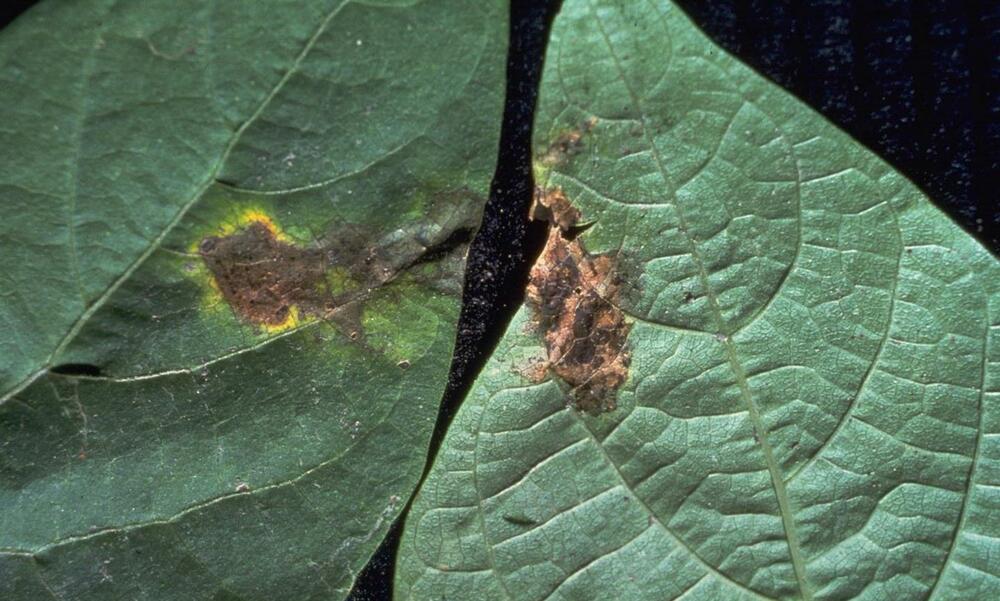
Leaf lesions caused by bean bacterial blight

Symptoms of bacterial blight on bean leaves
Symptoms
Water-soaked spots on leaves which enlarge and become necrotic; spots may be surrounded by a zone of yellow discoloration; lesions coalesce and give plant a burned appearance; leaves that die remain attached to plant; circular, sunken, red-brown lesion may be present on pods; pod lesions may ooze during humid conditions.
Cause
Bacterium
Comments
Management
Plant only certified seed; plant resistant varieties; treat seeds with an appropriate antibiotic prior to planting to kill off bacteria; spray plants with an appropriate protective copper based fungicide before appearance of symptoms.
Bacterial brown spot
Pseudomonas syringae
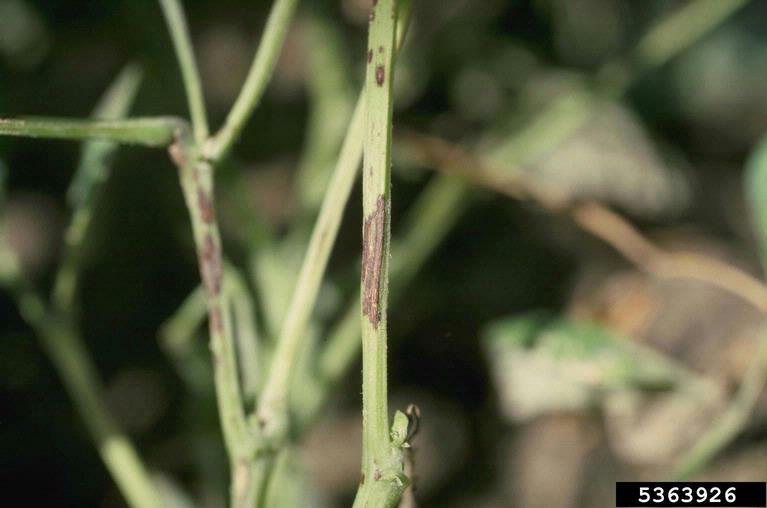
Bacterial brown spot on dry bean- branch lesions.

symptoms

Lesions of bacterial brown spot on a bean pod.
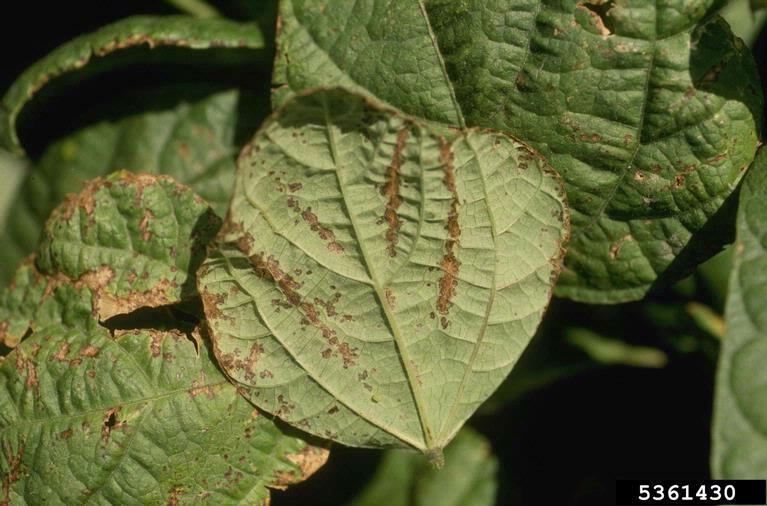
Bacterial brown spot disease symptoms

bacterial brown spot on dry bean, canopy shot - hole damage, early necrosis, disease, Pseudomonas syringae pv. syringae

Early shot-hole lesions on leaves of dry beans due to bacterial brown spot
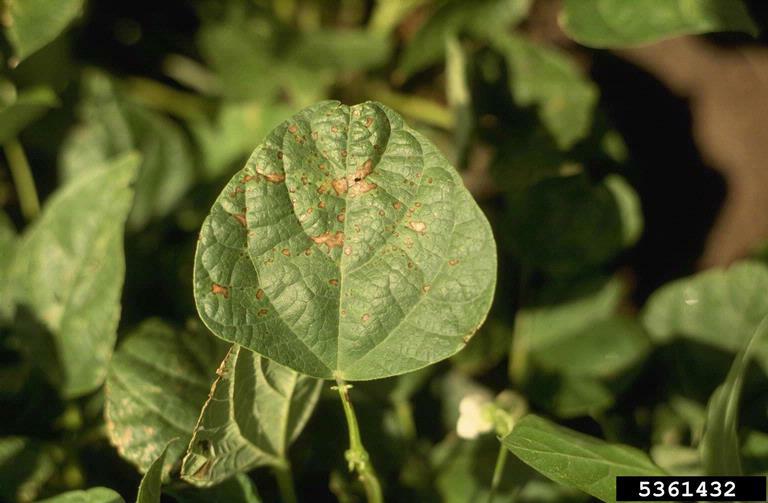
Infected leaf

"Water soaking" and necrosis on bean leaves, due to infection with bacterial brown spot disease
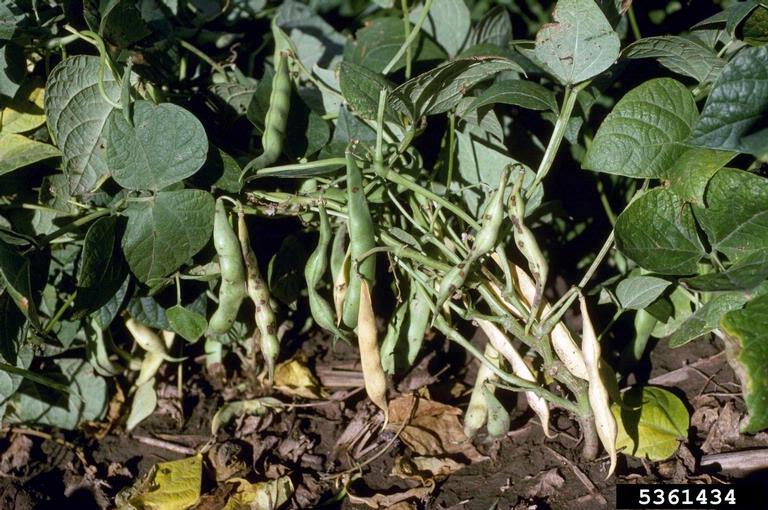
Infected bean pods

Cupping of young leaflets of dry beans, a symptom of bacterial brown spot disease
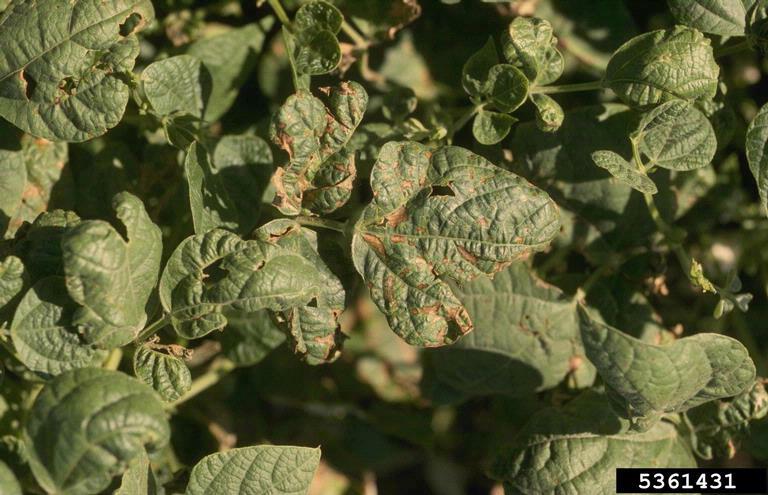
Symptoms of bacterial brown spot

Symptoms of bacterial brown spot (Pseudomonas syringae pv. syringae) on foliage of dry beans.
Symptoms
Small, dark brown necrotic spots on leaves which may be surrounded by a zone of yellow tissue; water soaked spots on pods which turn brown and necrotic; pods may twist and distort in area of infection.
Cause
Bacterium
Comments
Management
Plant only certified seed; rotate crops regularly; remove crop debris from field after harvest.
Halo blight
Pseudomonas savastanoi pv. phaseolicola
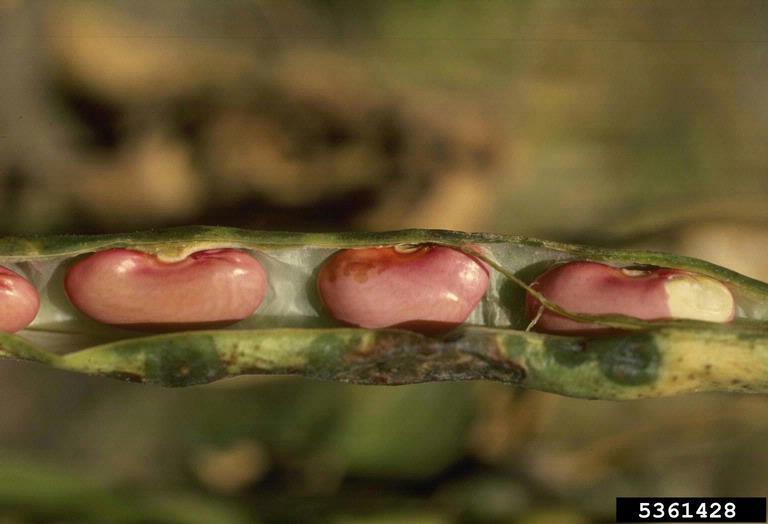
Halo blight "water soaking" on a mature pod of red kidney beans

Halo blight "water soaking" on a young bean pod
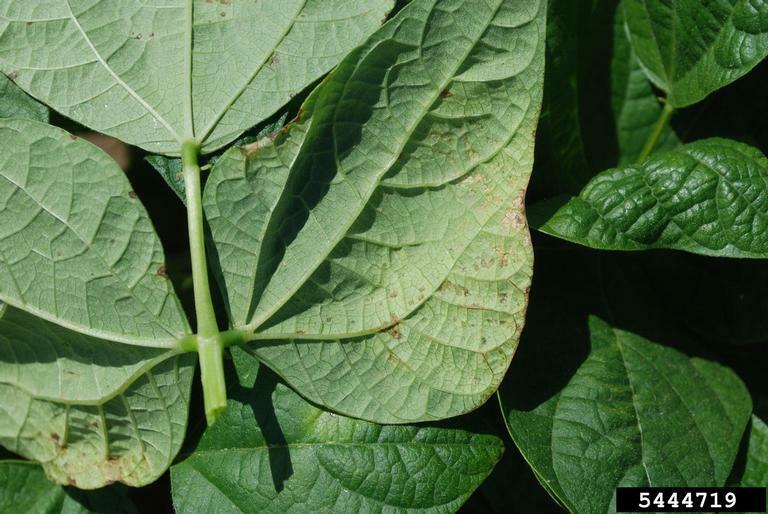
halo blight symptoms on lower surface of common bean leaflet, note small water-soaked spots

Halo blight chlorosis on bean leaves
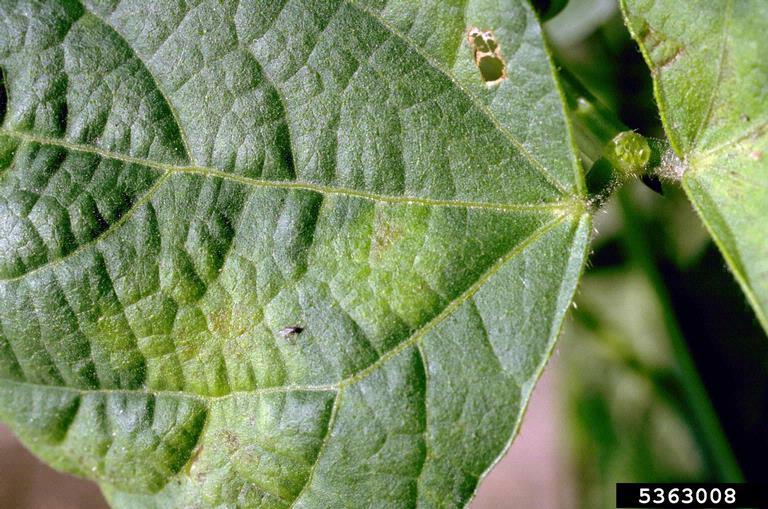
Chlorosis

halo blight symptoms on upper surface of common bean leaflet, note circular yellow spots

Chlorosis and isolated lesions of halo blight on dry beans.
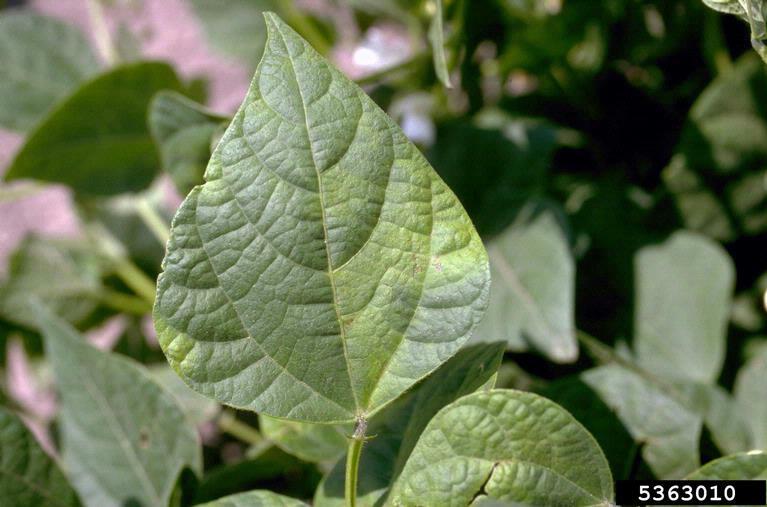
Halo blight chlorosis

Infected plants
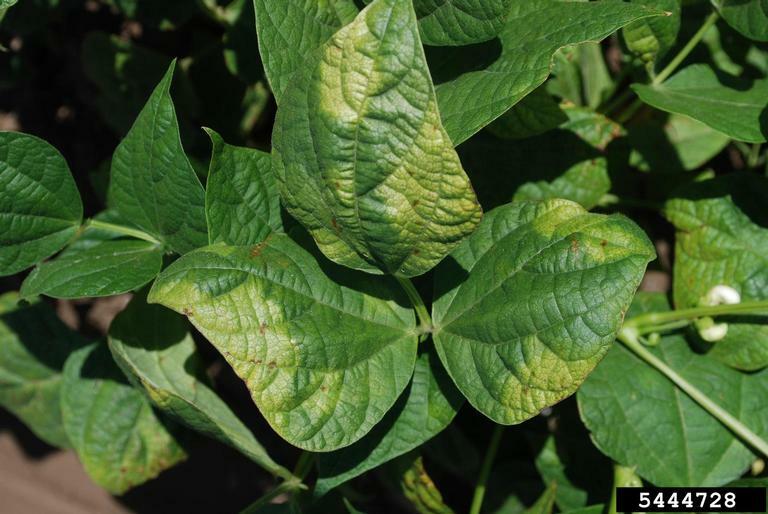
Halo blight symptom

Halo blight "water soaking" on a mature bean pod

Symptoms of halo blight on bean pods
Symptoms
Small water-soaked spots on underside of leaves which turn necrotic and become visible on upper surface; lesions may develop an area of chlorotic tissue around the spots; lesions on expanding leaves may cause distorted leaves; red-brown lesions may be visible on pods; pod lesions may ooze or may turn tan in color.
Cause
Bacterium
Comments
Management
Plant disease free seed or treat seed with an antibiotic to reduce levels of bacterium; rotate crops to non-hosts every 2 years; plow bean debris deeply in soil after harvest.
Category : Fungal, Oomycete
Damping-off
Rhizoctonia solani
Pythium sp.
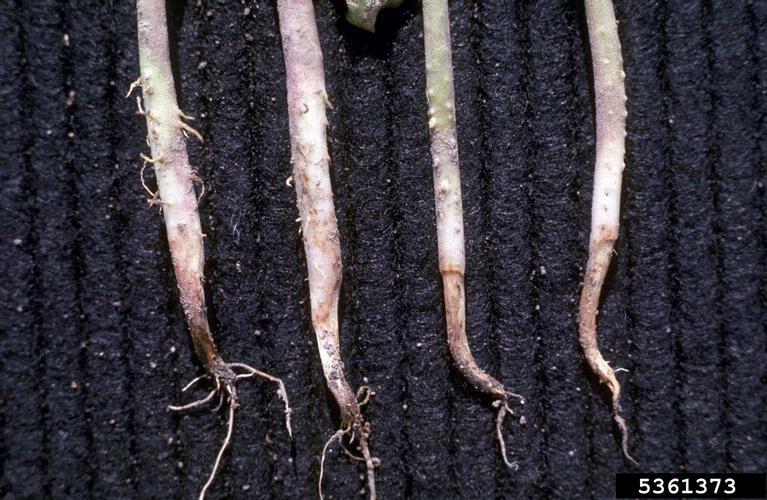
Drybean seedlings showing symptoms of Pythium damping off caused by Pythium spp.

Roots of drybean seedlings showing early symptoms of Rhizoctonia root rot caused by Rhizoctonia solani.

elongated sunken reddish-brown lesions on roots and stems at or below the soil line
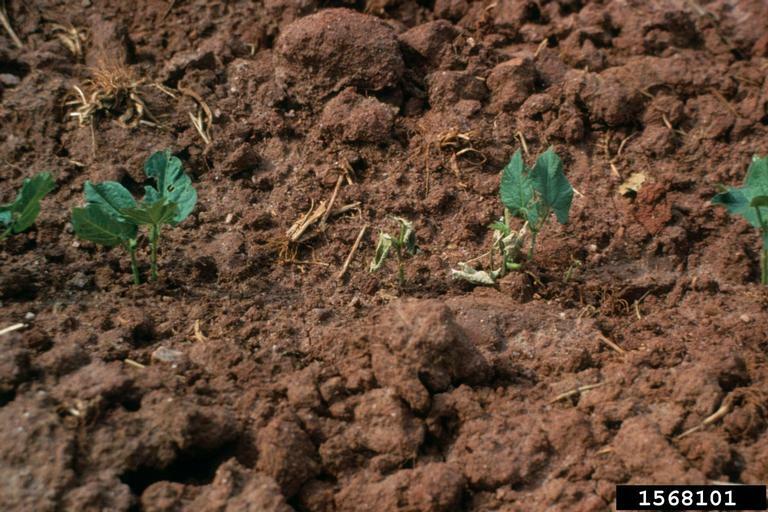
Death of seedling due to damping off
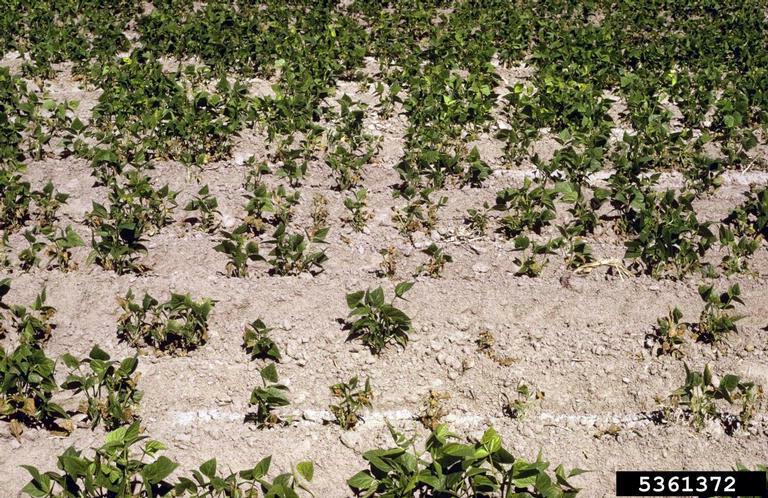
Drybean plants showing symptoms of Rhizoctonia and Pythium root rots caused by Rhizoctonia solani and Pythium spp. respectively in the field.

Roots of drybeans showing advanced symptoms of Rhizoctonia root rot caused by Rhizoctonia solani.

Infected seedling

Fusarium damping-off (Fusarium solani) symptoms

Damping Off on Snap Bean (Pythium and Rhizoctonia) Collapse of the lower stem area.
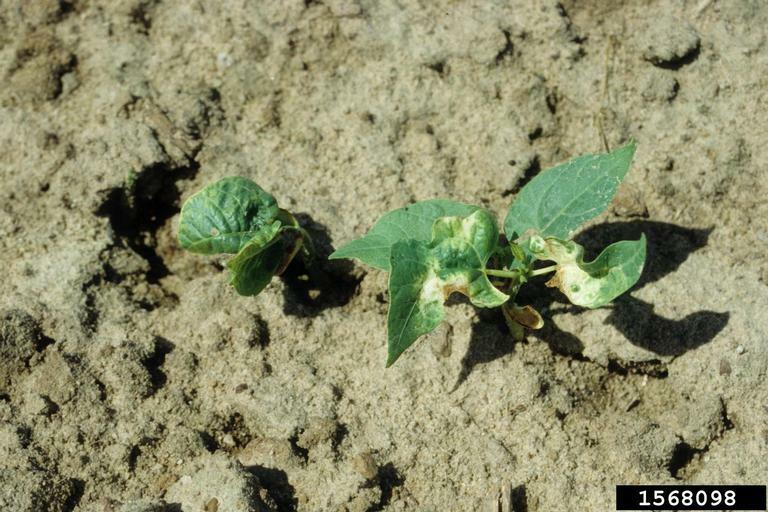
Rhizoctonia damping-off, blight and rot (Rhizoctonia solani) symptoms
Symptoms
The pathogens attack any stage of crop beginning from seed rot; damping off of seedlings; or stunting, yellowing and death of older plants. Visible symptoms are the appearance of elongated sunken reddish-brown lesions on roots and stems at or below the soil line. Further the lesions girdle the stem, causing the death of the plant. Older plants may show little indication of the disease, although yields may be reduced. The pith may turn brick- red if invaded by the fungus.
Cause
Fungus
Comments
Management
Follow crop rotation with non host crops. Sow the seeds in warm soil with well prepared seed bed and proper depth. Treat seeds with a suitable fungicide.
Category : Viral
Mosaic
Bean common mosaic virus (BCMV)
Bean common mosaic necrosis virus (BCMNV)

Drybean leaflets showing symptoms
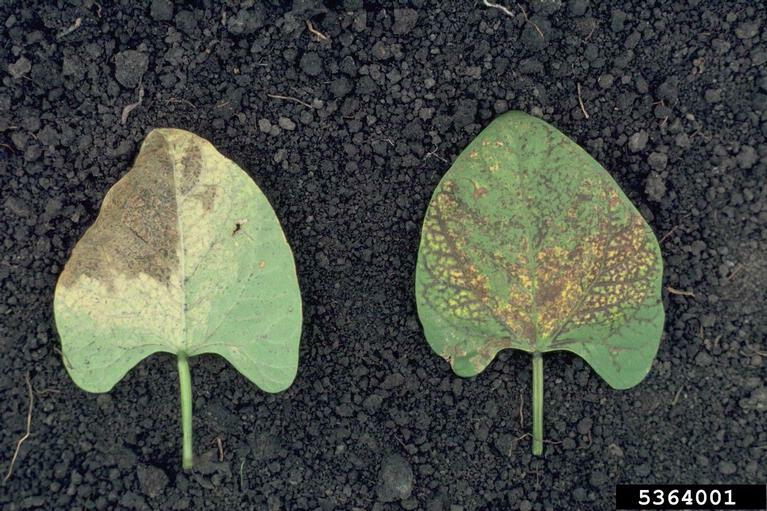
Leaves of a common bean plant showing symptoms of primary leaf necrosis caused by the Bean Common Mosaic Virus (BCMV).

A common bean plant showing symptoms of black root wilting caused by the Bean Common Mosaic Virus (BCMV).

Infected plant
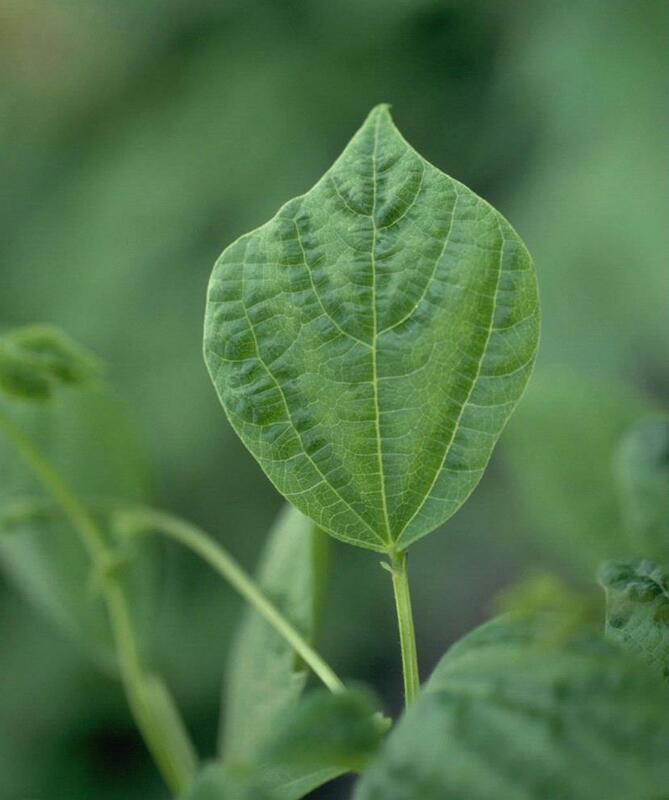
Bean common mosaic virus symptoms on bean foliage

Infected leaves

Pods of common beans showing symptoms of black root necrosis caused by the Bean Common Mosaic Virus (BCMV).

A common bean plant showing symptoms of stunting caused by the Bean Common Mosaic Virus (BCMV)
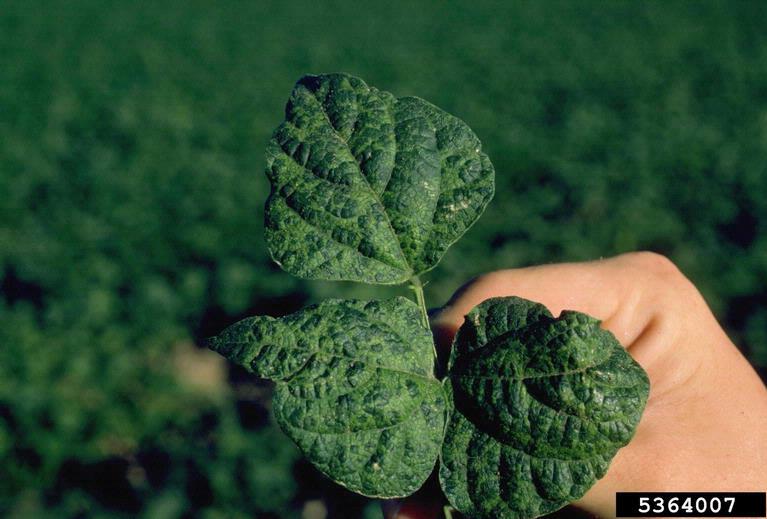
Bean yellow mosaic on a bean leaflet showing the mosaic pattern

Dry bean plants showing symptoms of Bean Common Mosaic Virus.

A common bean plant showing symptoms of black root necrosis caused by the Bean Common Mosaic Virus (BCMV).

A common bean leaf of an infected plant showing leaf cupping and mosaic
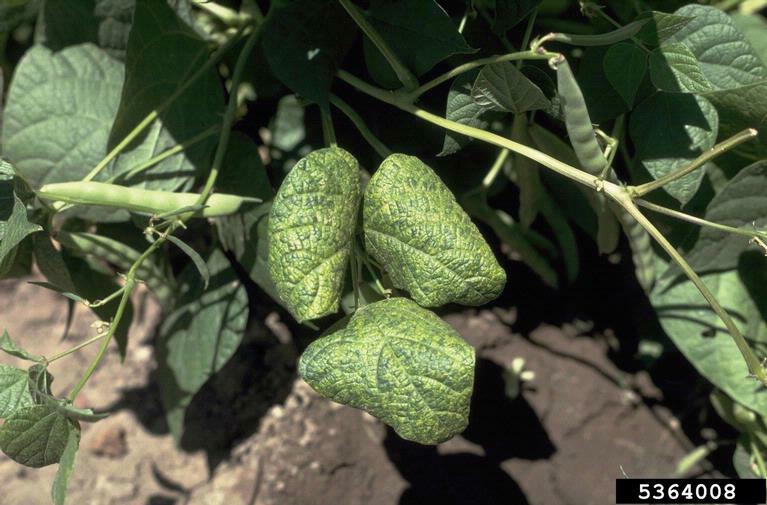
Bean yellow mosaic virus on a bean leaflet showing the mosaic pattern as caused by the Bean Common Mosaic Virus (BCMV).
Symptoms
Mottled dark and light green patterns on leaves; leaves may be distorted; yellow dots may be present on leaves; growth of plant may be reduced.
Cause
Viruses
Comments
Management
Plant only virus-free seed; plant resistant varieties.
Pests
Category : Insects
Aphids (Cowpea aphid, Pea aphid, etc.)
Aphis craccivora
Acyrthosiphon pisum

Black Bean Aphid Aphis fabae

The aphids are tended by ants
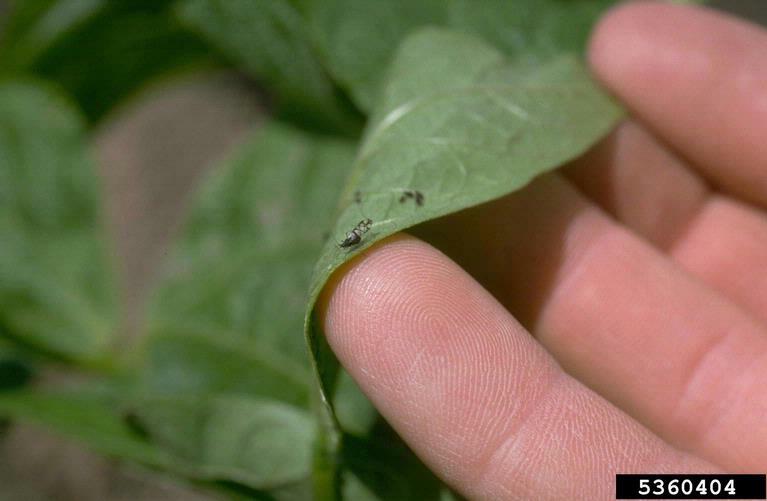
Winged aphids, the vectors of Bean Common Mosaic Virus (BCMV), on a bean leaflet.
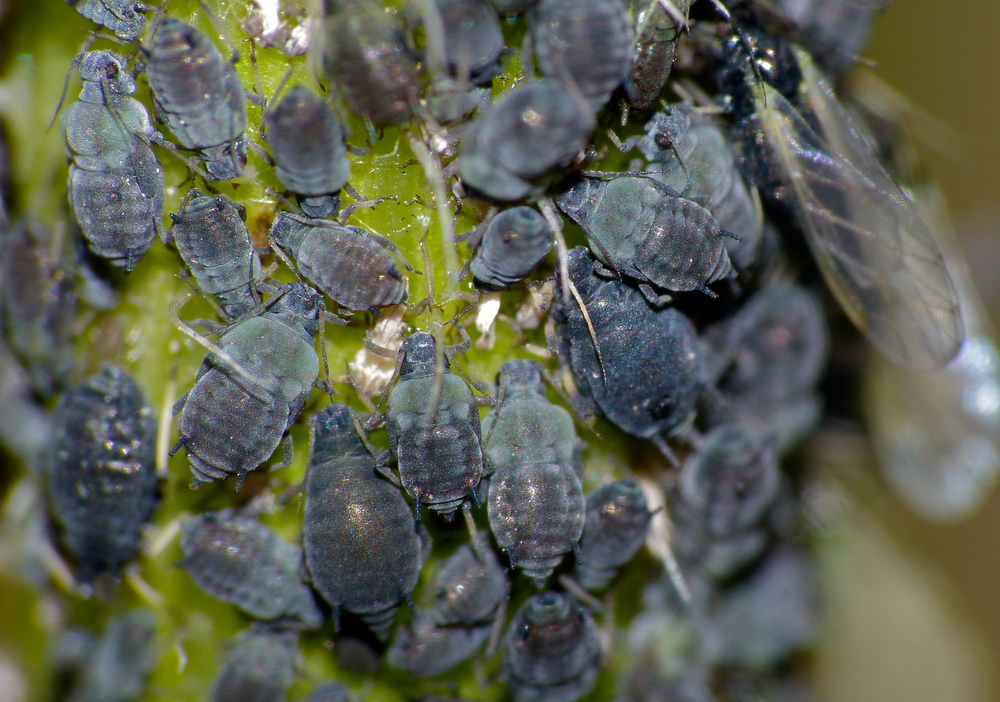
Close-up of Black Bean Aphids (Aphis fabae) colony

Aphids on lower surface of leaves

Aphid infestation on bean plant

Cowpea aphid (Aphis craccivora) infestation

Ladybird beetle feeding on bean black aphids

Pea aphid
Symptoms
Small soft bodied insects on underside of leaves and/or stems of plant; usually green or yellow in color, but may be pink, brown, red or black depending on species and host plant; if aphid infestation is heavy it may cause leaves to yellow and/or distorted, necrotic spots on leaves and/or stunted shoots; aphids secrete a sticky, sugary substance called honeydew which encourages the growth of sooty mold on the plants.
Cause
Insect
Comments
Management
If aphid population is limited to just a few leaves or shoots then the infestation can be pruned out to provide control; check transplants for aphids before planting; use tolerant varieties if available; reflective mulches such as silver colored plastic can deter aphids from feeding on plants; sturdy plants can be sprayed with a strong jet of water to knock aphids from leaves; insecticides are generally only required to treat aphids if the infestation is very high - plants generally tolerate low and medium level infestation; insecticidal soaps or oils such as neem or canola oil are usually the best method of control; always check the labels of the products for specific usage guidelines prior to use.
Armyworms (Beet armyworm, Western striped armyworm)
Spodoptera exigua
Spodoptera praefica

Adult of beet armyworm

Beet armyworm egg mass hatching

Damage due to early stage beet army worm larvae
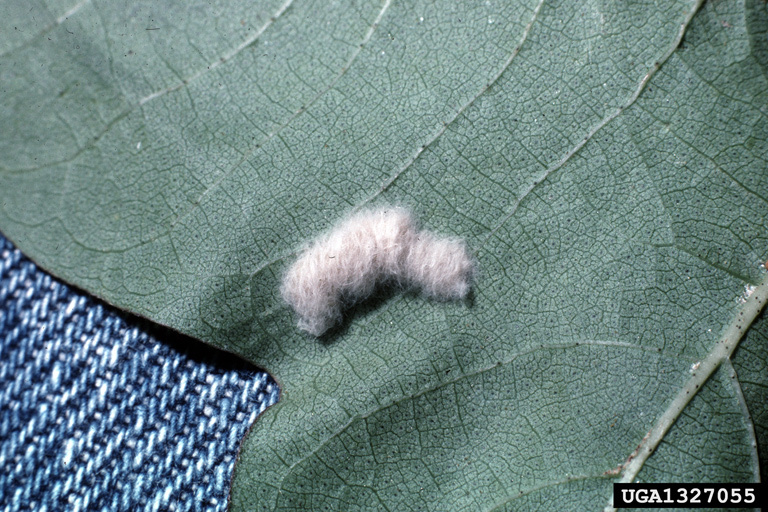
Beet armyworm (Spodoptera exigua) egg mass covered with hairs.

Beet armyworm adult

Beet armyworm eggs

Larvae of beet armyworm

Beet army worm late instar larvae

Beet armyworm (Spodoptera exigua) on leaf
Symptoms
Singular, or closely grouped circular to irregularly shaped holes in foliage; heavy feeding by young larvae leads to skeletonized leaves; shallow, dry wounds on fruit; egg clusters of 50-150 eggs may be present on the leaves; egg clusters are covered in a whitish scale which gives the cluster a cottony or fuzzy appearance; young larvae are pale green to yellow in color while older larvae are generally darker green with a dark and light line running along the side of their body and a pink or yellow underside.
Cause
Insect
Comments
Management
Organic methods of controlling armyworms include biological control by natural enemies which parasitize the larvae and the application of Bacillus thuringiensis; there are chemicals available for commercial control but many that are available for the home garden do not provide adequate control of the larvae.
Corn earworm
Helicoverpa zea

Larvae feeding on leaf
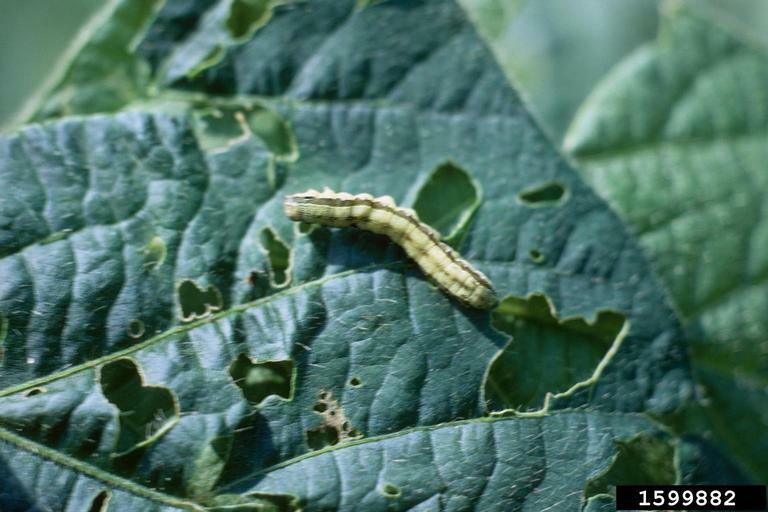
Damages leaf
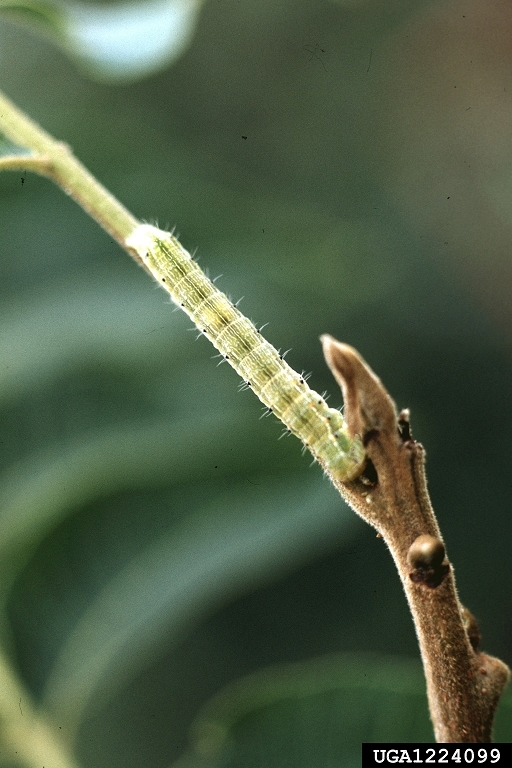
Larvae
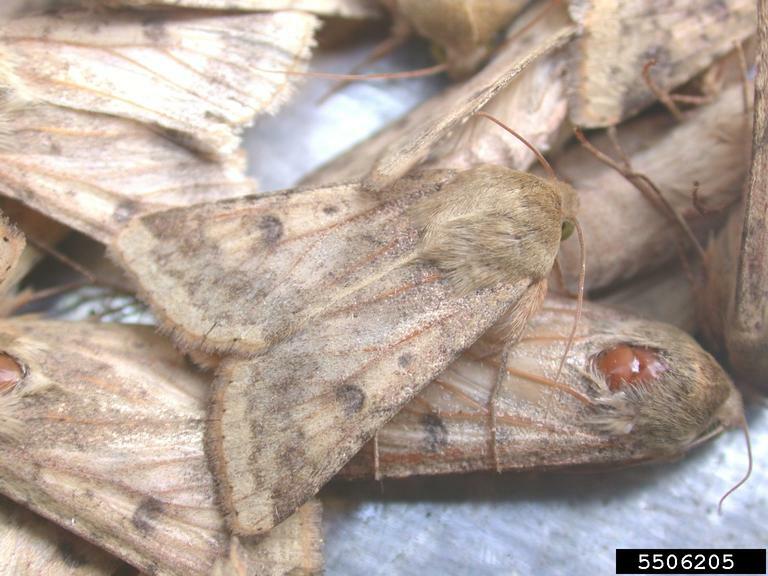
Corn earworm (Helicoverpa zea) adults

Adult and larvae
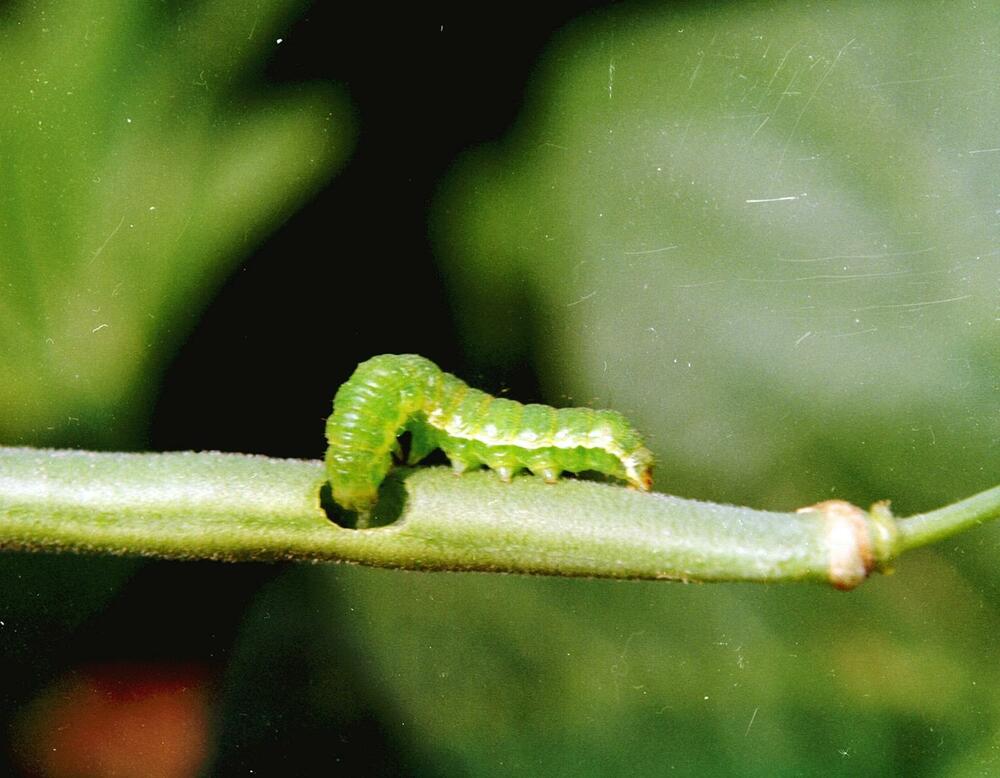
Corn earworm on bean
Symptoms
Larvae damage leaves, buds, flowers, pods and beans; young caterpillars are cream-white in color with a black head and black hairs; older larvae may be yellow-green to almost black in color with fine white lines along their body and black spots at the base of hairs; eggs are laid singly on both upper and lower leaf surfaces and are initially creamy white but develop a brown-red ring after 24 hours and darken prior to hatching.
Cause
Insect
Comments
Management
Monitor plants for eggs and young larvae and also natural enemies that could be damaged by chemicals; Bacillus thuringiensis or Entrust SC may be applied to control insects on organically grown plants; appropriate chemical treatment may be required for control in commercial plantations.
Cutworms
Agrotis spp.
Peridroma saucia
Nephelodes minians
and others

Bean leaf skeletonizer (Autoplusia egena) larva

Cutworm damage to bean seedling
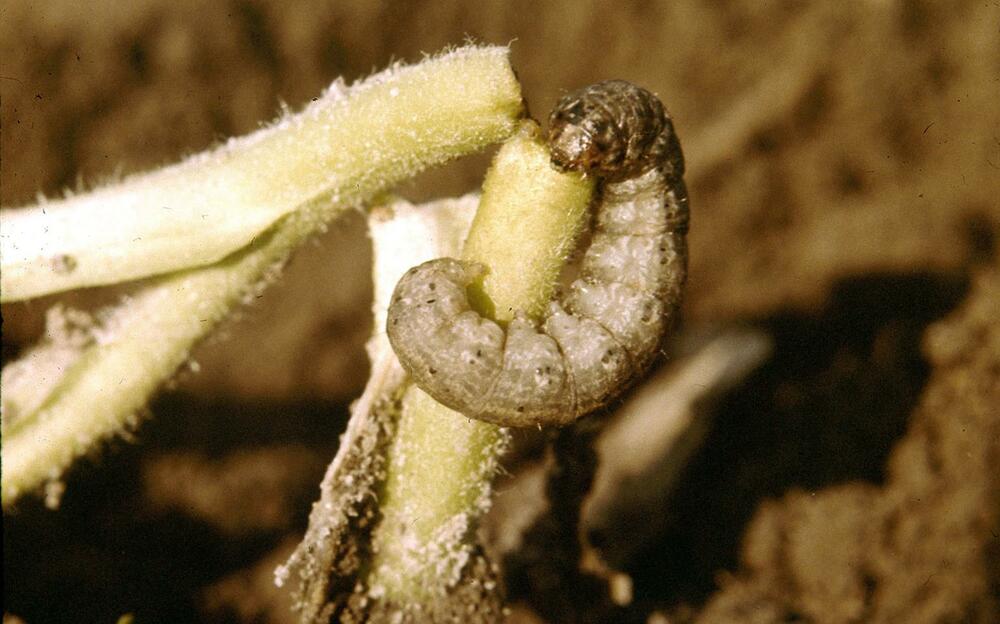
Cutworm larva severing plant stem

French beans attacked by Helicoverpa armigera. Note the larvae within the bean.
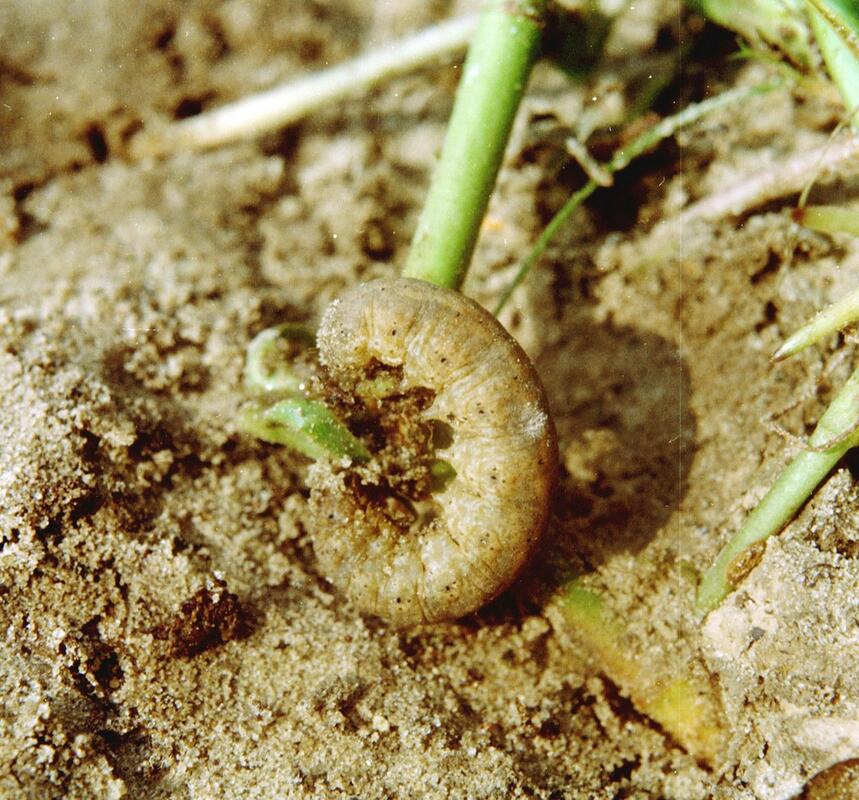
Cutworm feeding on plant stem

Eggs of western bean cutworm (Striacosta albicosta)

Cutworms will curl up into a characteristic C shape when disturbed
Symptoms
Stems of young transplants or seedlings may be severed at soil line; if infection occurs later, irregular holes are eaten into the surface of fruits; larvae causing the damage are usually active at night and hide during the day in the soil at the base of the plants or in plant debris of toppled plant; larvae are 2.5–5.0 cm (1–2 in) in length; larvae may exhibit a variety of patterns and coloration but will usually curl up into a C-shape when disturbed.
Cause
Insects
Comments
Management
Remove all plant residue from soil after harvest or at least two weeks before planting, this is especially important if the previous crop was another host such as alfalfa, beans or a leguminous cover crop; plastic or foil collars fitted around plant stems to cover the bottom 3 inches above the soil line and extending a couple of inches into the soil can prevent larvae severing plants; hand-pick larvae after dark; spread diatomaceous earth around the base of the plants (this creates a sharp barrier that will cut the insects if they try and crawl over it); apply appropriate insecticides to infested areas of garden or field if not growing organically.
Leafminers
Lyriomyza spp

Leafminer damage on bean plant leaf

Leafminer damage
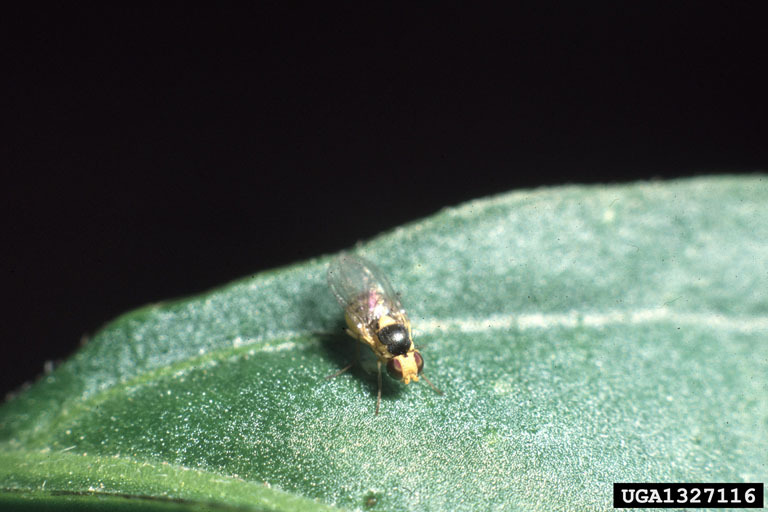
leafminer fly (Liriomyza sp.) adult

An infested common bean leaf showing tracts of the leaf miner Liriomyza sp.

Leafminer larvae

Larvae of leafminer

vegetable leafminer (Liriomyza sativae) on bean leaves

Tunnels caused by leafminer
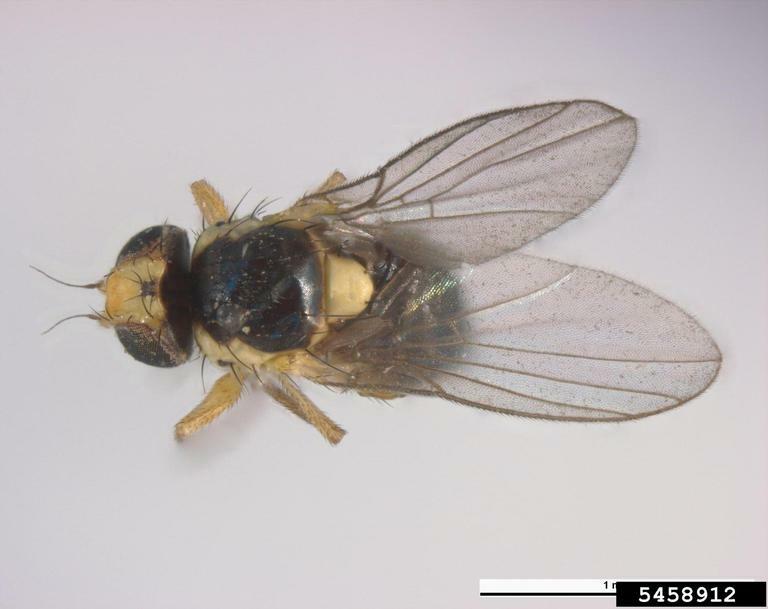
vegetable leafminer (Liriomyza sativae) adult
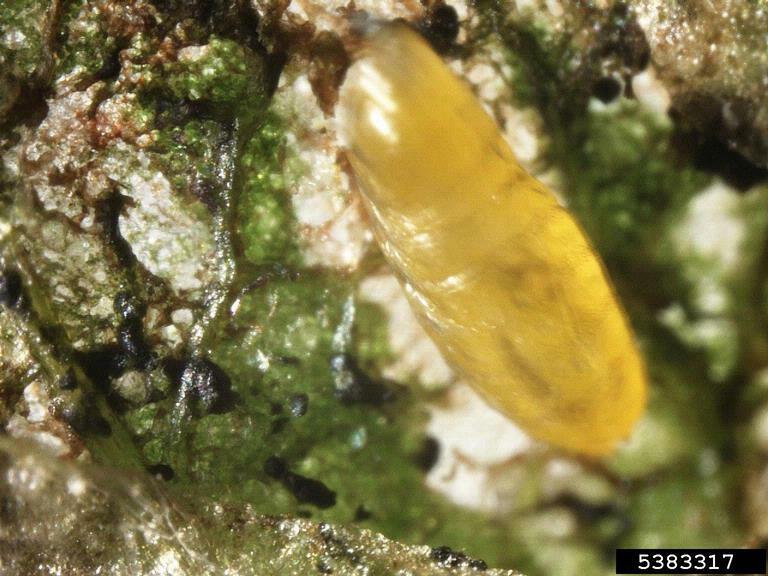
leafminer fly (Liriomyza sp.) pupa
Symptoms
Thin, white, winding trails on leaves; heavy mining can result in white blotches on leaves and leaves dropping from the plant prematurely; early infestation can cause fruit yield to be reduced; adult leafminer is a small black and yellow fly which lays its eggs in the leaf; larvae hatch and feed on leaf interior.
Cause
Insects
Comments
Management
Check transplants for signs of leafminer damage prior to planting; remove plants from soil immediately after harvest; only use insecticides when leafminer damage has been identified as unnecessary spraying will also reduce populations of their natural enemies.
Loopers (Cabbage looper, Alfalfa looper)
Trichoplusia ni
Autographa californica

soybean looper (Thysanoplusia orichalcea) on dry beans
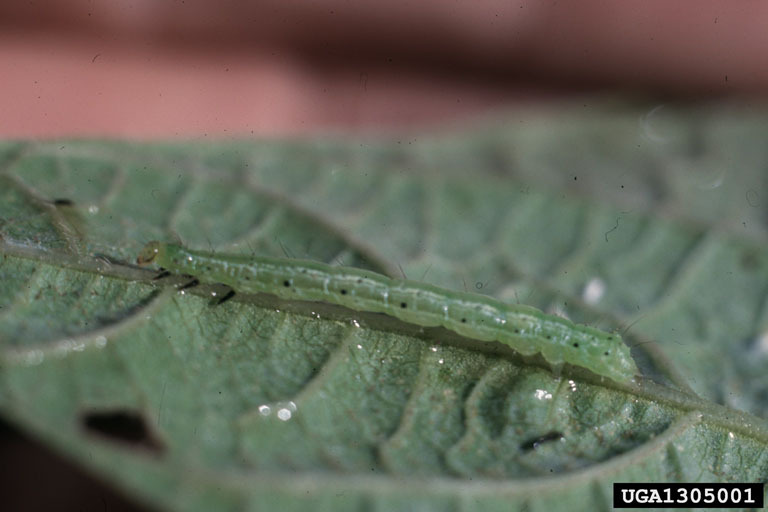
Looper on bean leaf

Cabbage looper
Symptoms
Large or small holes in leaves; damage often extensive; caterpillars are pale green with a white lines running down either side of their body; caterpillars are easily distinguished by the way they arch their body when moving; eggs are laid singly, usually on the lower leaf surface close to the leaf margin, and are white or pale green in color.
Cause
Insect
Comments
Management
Looper populations are usually held in check by natural enemies; if they do become problematic larvae can be hand-picked from the plants; an organically acceptable control method is the application of Bacillus thuringiensis which effectively kills younger larvae; chemical sprays may damage populations of natural enemies and should and should be selected carefully.
Mexican bean beetle
Epilachna varivestis
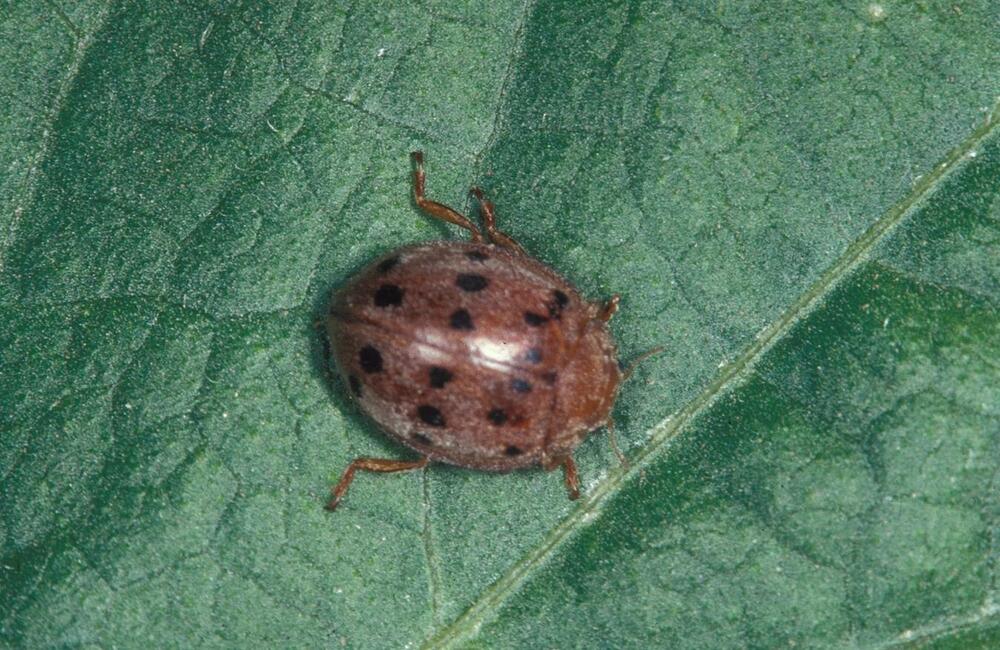
Adult Mexican bean beetle

Mexican bean beetle damage to bean foliage

Adult beetle and damage to bean foliage

Eggs laid on underside of bean leaf

Mexican bean beetle larva

Bean plant infested with Mexican bean beetle larvae
Symptoms
Irregular patches of feeding damage on underside of leaves which causes the top surface of the leaf to dry out, giving the leaves a lacy appearance; insect will also damage flowers and small pods; pods may be damaged so badly that they drop from the plant; adult insect is an orange-brown beetle with black spots; larvae are fat-bodied grubs which taper at the end and are in rows of conspicuous spines
Cause
Insect
Comments
Management
Some bean varieties may be less attractive hosts for the beetle, e.g. snapbeans are preferred hosts over lima beans; early varieties may escape damage form beetles beetle populations can be reduced by remove overwintering sites such as brush and leaves on the ground; handpick larvae and adults; brush eggs from leaves and destroy; apply insecticidal soap to leaf undersides if infestation is heavy
Stinkbugs (Consperse stinkbug, etc.)
Euschistus conspersus

Florida Preatory Stink Bug, Euthyrhynchus floridanus (beneficial insect)

Globular stinkbug on leaf
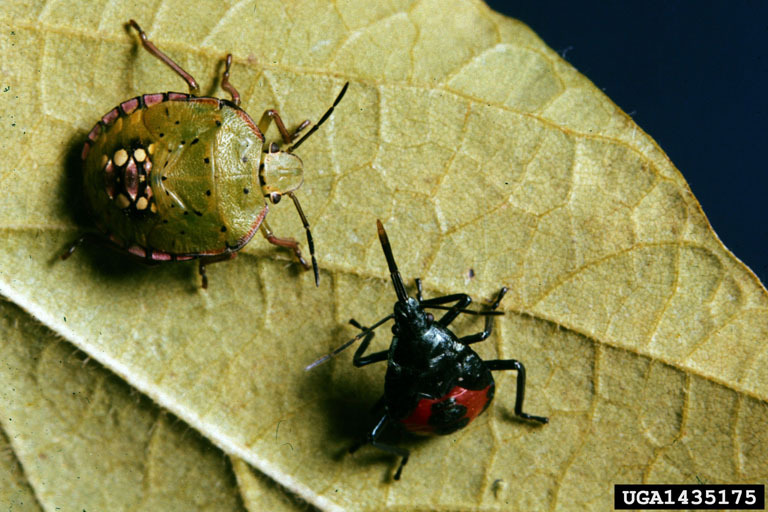
Predaceous anchor stink bug (Stiretrus anchorago) attacking green stinkbug nymph.

Stinkbug feeding on bean pod

Southern stinkbug feeding on bean leaf

Consperse stinkbug

brown stink bug (Euschistus servus) eggs
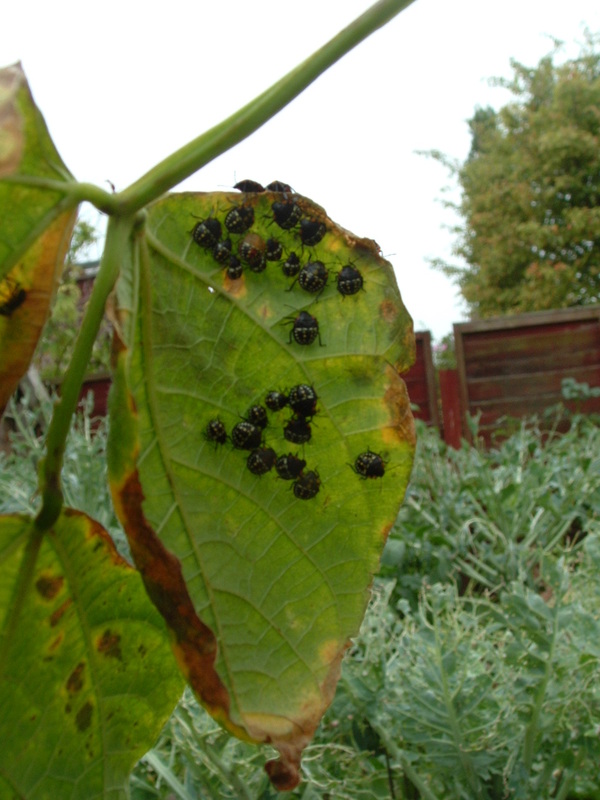
Stinkbugs infestation on bean leaves
Symptoms
Dark colored pinpricks on fruit surrounded by a lighter area that turns yellow or remains light green; stink bugs often carry pathogens in their mouthparts which can cause secondary infections and decay of fruit; adult insect is shield-shaped and brown or green in color; may have pink, red or yellow markings; eggs are drum shaped and laid in clusters on the leaves; larvae resemble the adults but are smaller.
Cause
Insect
Comments
Management
Remove weeds around crop which may act as overwintering sites for stink bugs and practice good weed management throughout the year; organically accepted control methods include the use of insecticidal soaps, kaolin clay and preservation of natural enemies; chemical treatments are not recommended for tomatoes that are to be processed for paste or canning unless secondary infections with other pathogens are a concern.
Category : Mites
Spider mites (Two-spotted spider mite)
Tetranychus urticae
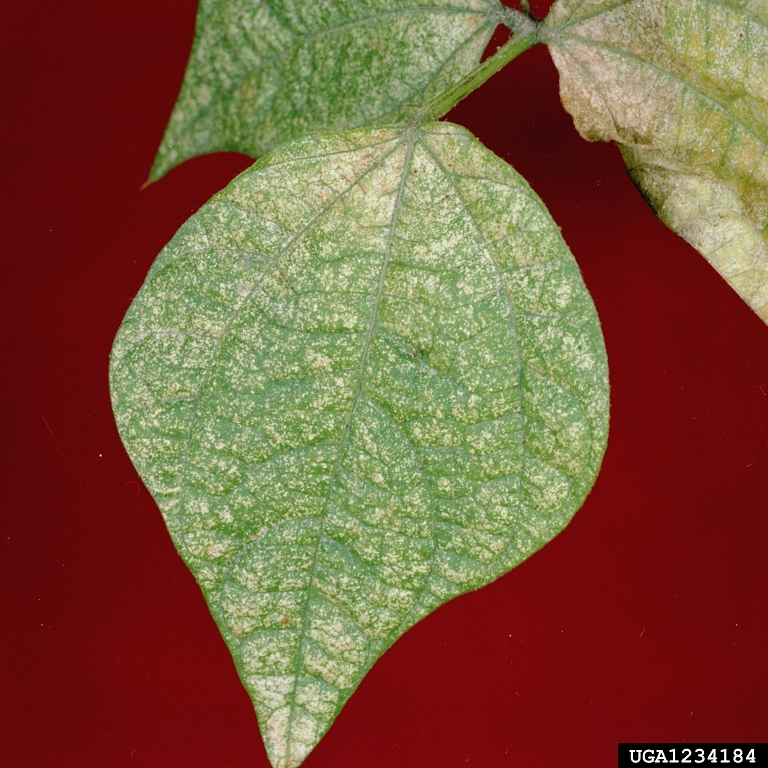
Spider mite symptoms on upper surface of leaves
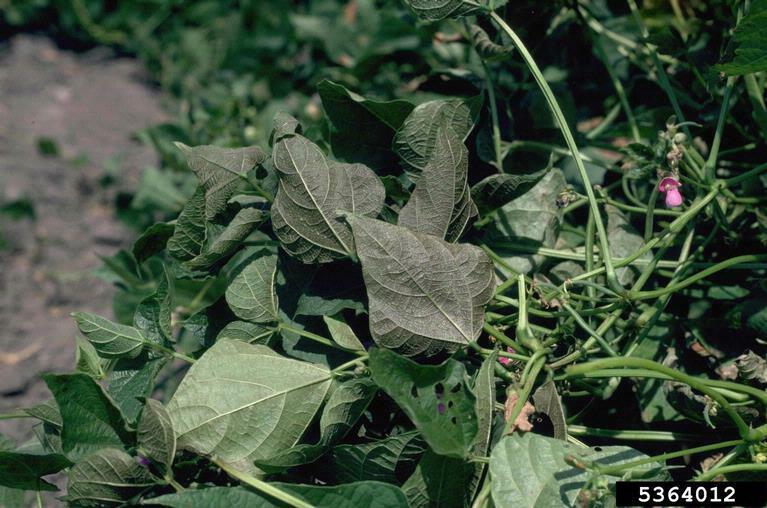
Tropical spider mites necrosis to bean leaves on the field.

Spider mite infestation on bean foliage

Stippling injuries to leaves due to spider mites

Underside of a bean leaf showing spider mites.
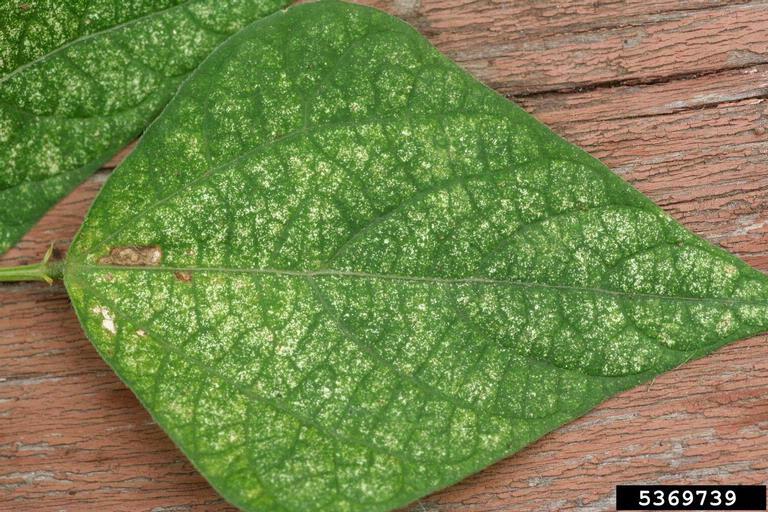
Damaged leaf

Spider mite infestation on lower surface of leaf
Symptoms
Leaves stippled with yellow; leaves may appear bronzed; webbing covering leaves; mites may be visible as tiny moving dots on the webs or underside of leaves, best viewed using a hand lens; usually not spotted until there are visible symptoms on the plant; leaves turn yellow and may drop from plant.
Cause
Arachnid
Comments
Management
In the home garden, spraying plants with a strong jet of water can help reduce buildup of spider mite populations; if mites become problematic apply insecticidal soap to plants; certain chemical insecticides may actually increase mite populations by killing off natural enemies and promoting mite reproduction.

















































































































































































